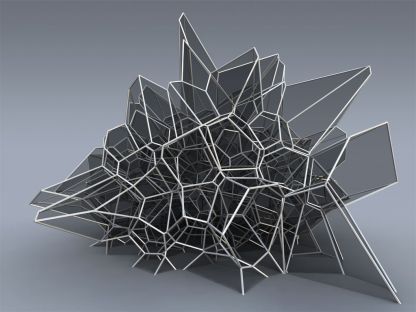 Scripting the Future -by Neil Leach
Scripting the Future -by Neil LeachCode, it would seem, is everywhere. We are beginning to understand that much of our natural environment is based on rule-based behaviors, from the emergent swarm intelligence of flocks of birds and schools of fish, to the complex patterns on snow flakes, ferns, sea shells and zebra skins. And nothing escapes. Not even the human body. The human genome is being mapped out and sequenced by scientists to provide a genetic blueprint of human life itself.
In this context, it is hardly surprising that architects are now beginning to explore similar principles in the design studio. The apparent primacy of these codes opens up the possibility of modelling systems through digital means, and with it the possibility of using digital means to breed structures. An emerging group of young architects is using the technique of ‘scripting’ – the manipulation of digital code – to produce radically innovative architectural environments. A new generation of structures is being created, that recognizes the potential of the computer not just as a sophisticated drafting and rendering tool, but as a potentially powerful tool in the generation of designs themselves.

We are witnessing a fresh and highly innovative vocabulary of architectural forms, generated by the algorithmic potential of the computer – from the proliferating logic of cellular aggregation, to the adaptive, parametric behaviour of distributive systems mutating across a landscape. So too, we are witnessing a shift in the status of digital operations from a marginalized domain of experimentation to a central role in the production of architectural information. Few significant architectural offices can afford not to engage with advanced digital modelling, which was once limited to the province of the avant-garde.
But the real potential of scripting lies perhaps beyond questions of innovative form. For what this realm offers is not so much an extension to postmodern scenographic form-making, but a critique of that realm. With increasing concerns for sustainability and efficiency, the need to optimize performance in terms of environmental, structural, economic and other concerns, demarcates a new ethical horizon of possibilities. Digital tools can be used not only to model and test performance, but also to generate efficient buildings in the first place. In other words, once a performative logic has been written into a script, the results are already optimized.
This, then, is the logic of scripting, a logic whose potential is to focus more on process than representation, more on performance than appearance. We might speak, then, not of forms as such, but ‘formations’ – formations informed by performative considerations, buildings as landscapes of information.
This exhibition offers us a Pandora’s box of architectural tricks and treats, and one, which, now unleashed, seems set to spread like a virus across the full range of architectural production. In this sense, this exhibition is a presage of the future – the scripting of the very future of architectural production.
- Neil Leach




No hay comentarios:
Publicar un comentario